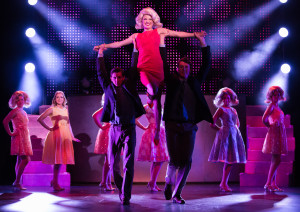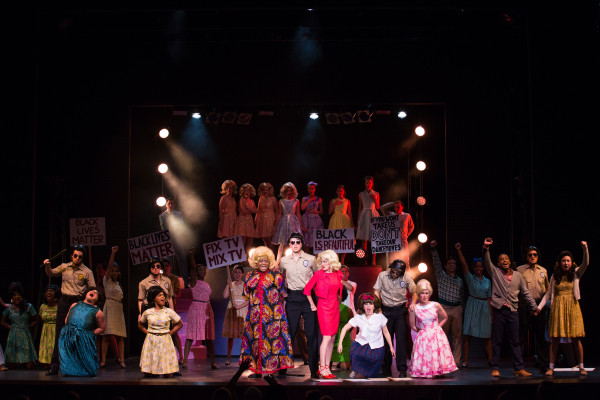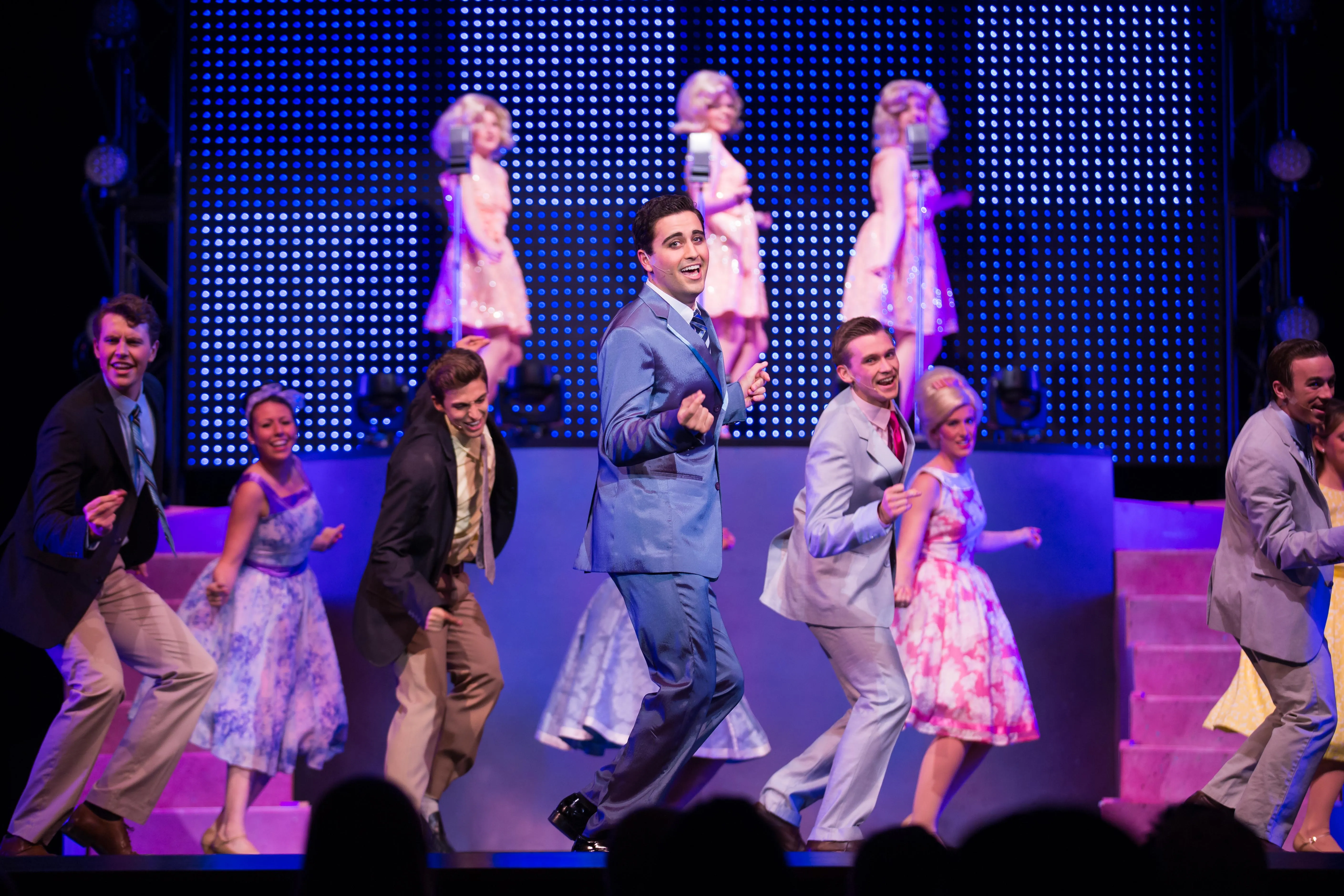Ram’s Head Theatrical Society’s production of “Hairspray,” which opened this past weekend at Memorial Auditorium to phenomenal campus-wide reception, is an amalgam of some of the most outstanding talent the Stanford theater scene has to offer. With the kind of energy that inspires people to go home, throw on a pair of high heels and dream of life under the lights, “Hairspray” had me feeling optimistic, in spite of my doubts about the ability of this particular show to spark genuine debate about racial representation in theater. Under the vision of accomplished director Ken Savage ’14 and produced by James Sherwood ’17, “Hairspray” ultimately serves as a successful step towards beginning to address racial issues within Stanford’s theater community.
The year is 1962 — the height of the civil rights era. In place of traditional theater haze, aerosol drifts across the set. The music of a fabulous house band fills the room, and a massive video wall containing 20,000 LED lights transforms Memorial Auditorium into a virtual television studio and its audience into a teeming crowd of virtual viewers. Opening with a glamorous Baltimore cityscape, accompanying the many dance scenes with moving checkerboard patterns and at one point even becoming a campy backdrop of falling stars, the video wall (programmed by Matt Lathrop ’16) represents one of the most innovative unions of technology and performance to have graced Memorial Auditorium’s stage.
The show is brimming with ambitious, high-energy dance numbers (choreographed by former Dollies Amber Quiñones ’15, Tayna Gonzales ’15, Emily Giglio ’15 and Dafna Szafer ’15) that made it almost impossible to sit still. The star of the show, an unpopular yet spirited teenager named Tracy Turnblad (Jessia Hoffman ’15), dreams of dancing on television’s Corny Collins Show with her love interest, the talented Link Larkin (Matt Herrero ‘17). When finally given the opportunity to audition, Tracy is forced to face the ugly realities of mainstream media — both its standards in regards to aesthetic beauty and its blatant racism towards black performers.

Throughout the show, an appreciation of black music and black art is present — if not the radicalism and autonomy of black politics — and performers of color are given one of the few mainstream platforms in Stanford’s recent theatrical history upon which to dazzle us. Television’s “Negro Day” singing trio, known as the Dynamites (played by Samantha Williams ’17, Shavana Talbert ’16 and Willie Hercule ’16), brought the house down with the number “The New Girl in Town.” Ladidi Garba’s ’14 heart-stopping performance as Motormouth Maybelle, the host of “Negro Day,” is the musical pinnacle of the show, moving dozens of people to their feet mid-performance. Nick Biddle’s ’14 drag performance as Edna Turnblad, Tracy’s charismatic mother, is a comedic highlight, making me question many times which shone brighter: his personality or the sequins plastered to him throughout the show. Also noteworthy were the hysterical Wilbur Turnblad (Brady Richter ’15) and Velma Von Tussle (Lucie Fleming ’17), the horrendous producer of the Corny Collins Show who was perhaps just a little too fun for us to hate.
Make no mistake: “Hairspray” has been subject to a long history of debate regarding its treatment — and mistreatment — of race. Though the plot makes efforts to address issues of segregation, representation politics and other forms of racial injustice, Tracy Turnblad, the show’s enthusiastic protagonist, ultimately fills the classic archetype of the white savior: the well-meaning ally whose courage and steadfast moral compass lead an otherwise helpless black community towards equality. And unfortunately, the show’s light handling of traumatic issues such as police terror and incarceration admittedly makes it somewhat difficult to compare this narrative with that of the #BlackLivesMatter movement today.

But Savage’s take on the classic story does, in many ways, strive to put a new spin on some of the more problematic moments in the show. When Tracy co-opts dance moves created by her friend Seaweed (played by the inordinately charming Robert Poole ’15) in order to land herself a spot on the show, the moment is not overlooked, as it has been in so many other large-scale productions of “Hairspray.” Rather than simply handing over his artistic integrity, as he does in the film version, Seaweed’s discomfort at Tracy’s utilization of his dance moves is made apparent and forces us to confront, if only briefly, the reality of cultural appropriation in mainstream media. When Seaweed introduces his blooming love interest (the light-skinned Penny, played by Hannah Hsieh ’17) to the rest of his community, he is met with looks of hurt and betrayal after delivering the line “the blacker the berry, the sweeter the juice” only a few scenes earlier. In addition, the role of Penny’s mother, the traditionally racist white housewife, is in this production played by an Asian-American woman — thus provoking questions regarding what it means to be “of color” in America and about the nuances of discrimination within different communities.
However, this celebration of diversity does not have to be limited to the walls of Memorial Auditorium. Stanford’s Institute of Diversity in the Arts (IDA), Everyday People and numerous events hosted by Harmony House and the Black Community Services Center work to support black art and provide year-round platforms for these kinds of conversations. In addition, Ram’s Head’s unique position as one of Stanford’s only student theater groups to charge for admission could have inspired them to go one step further and actually donate to these artistic endeavors or any number of organizations working to uplift black voices across the country.
While Ram’s Head’s production of “Hairspray” is more about exploring the magic of theater than moving us to action, its willingness to open this type of dialogue is significant — especially within the context of Stanford’s current attitudes towards racial injustice. To put it plainly, “Hairspray” is a must-see. Director Ken Savage’s bold attempt to take on a genre which is, essentially, a minefield of racial problems represents an important step in the right direction. Where this dialogue will take us, and how it will be manifested in future productions, is in your hands.
“Hairspray” will be playing in Memorial Auditorium April 16-18 at 8 p.m. Tickets are available at musical.stanford.edu.
Contact Madelaine Bixler at mbixler ‘at’ stanford.edu.
